What is the shape in slow motion?
A video was floating around on social media that caught my attention and served as the subject matter of this blog post. Shown below is a short video (less than 40 seconds) of a golf ball hitting a steel plate at 150 miles per hour:
Does the video seem strange to you? The video is in 'slow-motion.' The video has been 'sliced up' into 70,000 frames per second. I realize that the reader (you) might be confused by 'slicing up' a video into thousands of frames per second. The process is referred to as changing the 'frame rate.' The process is accomplished by filming the event (in this case using a 'high-speed' camera) with a special camera. Traditional film (movie film) is viewed at around 24 frames per second. To understand the concept further, see the diagram below. I found this diagram off of a 'branching' search.
Source:
The basic idea is to 'slice up' time into smaller pieces. In the diagram above, the bottom line could represent 1 second of film. The next line up would divide the 1 second of film (represented by 1 frame) into two frames -- line 2. Further dividing the film would result in line 3 with the original 1 second (1 frame) divided into 4 frames (still 1 second in total time duration). In the very top line, the maximum divisions is now 8 frames in 1 second. Are you confused yet by my choice of diagram and description? I understand completely.
How about another route (diagram) to convey the same concept of changing the 'frame rate.' Below is a more appropriate representation taken from a animation website:
Source: https://www.codeaurora.org/blogs/mbapst/measuring-fps-web
In the diagram above, one second of animation is expanded into 60 frames. Some people (opinions) think that the video above of the golf ball hitting the plate is fake. Specifically, that the motion (deformation) of the the golf ball throughout the flight is unbelievable. More specifically, that the deformation upon rebound is not possible. Is the opinion possible? Sure, why not. But.
As a chemist, I would reserve my judgment until I can absolutely disprove the video with further evidence. On a different note but similar in concept, every day matter (molecules, bulk material) appears to be 'rigid' and 'sturdy'. If the same material was viewed on a different length scale, 'perturbations' might be visible that were not evident at the previously viewed scale. One of the many beautiful aspects of science is that molecules (or bulk matter) is not static as it appears on the 'classical scale'. (More about this in a later post!!!)
I looked for another video to confirm the above motion. I found one -- which is shown below of a golf ball hitting a metal golf club at 150 mph filmed with a frame rate of 40,000 frames per second:
Regardless of whether the golf ball deforms to the extent upon impact as shown in the first video, the fact that the visualization is possible is amazing. Technology has advanced tremendously and allowed golf ball research to advance 'leaps and bounds.' Is any motion other than a 'rigid' ball possible during a golf game. And yes, their are instances where a golf ball will encounter (impact) a hard metal surface.
There are slight deformations that a ball undergoes during a golf club swing. Technology has allowed the deformation to be visualized. I have cut up or taken apart (into still pictures) the compression of a golf ball by a driver. Below are the photos -- which show deformation:
Before Impact
During impact!
After Impact!
Captured in the middle photo is the deformation or compression of the golf ball. This is maximum compression. After the golf ball leaves the impact, there is a visible 'deformation tail' -- slight deformation of the ball. None of this would have been possible without the use of a high-speed camera. What about the composition of the golf ball? What chemical aspect allows the ball to undergo the compression's seen in the frames above?
What is a Golf Ball made of?
In order to understand the compression (or deformation) that a golf ball adopts during a game, I probably should give a basic over view of what a golf ball is made of. When I decided to write the post a few days ago, I had not understanding of the composition of a golf ball. I would have guessed along the lines of the the center (of the golf ball) being a rubber core and then rubber winding's layered up until a 'hard core.'
To find the answer, I conducted a Google search and of the many results, one stood out. The University of Utah sports department has a blog, "Sports 'n Science", where questions regarding sports are answered. And the answers are comprehensive to say the least -- which I respect and love. In one post titled "Creating The Perfect Golf Ball With Chemistry (Basics)," the author describes the composition of a golf ball in a general manner:
The first modern golf ball consisted of a small, hard core wound with a long string of rubber and then coated with tree gum called gutta-percha (Mallon, 2011). Since then, many improvements have been made on golf balls to give them the perfect “feel” (i.e. a certain resilient, soft feel that golfers look for when their clubs make contact), but also great durability and wear and tear resistance. These two qualities tend to be mutually exclusive in a single material; however, scientists have developed balls with several layers, each layer addressing a specific need that the ball has.Researchers have targeted polymers, a long molecular chain made of many smaller subunit molecules linked together, as the best materials for golf balls. This is because polymers are very flexible – by changing even one atom in the subunit or twisting the subunit slightly, a polymer can go from being used for the hard golf ball cover to the more elastic inner layer.
The descriptive history leading up to the crucial parameter of choosing a 'polymer' with unique properties provides us with the essentials of the golf ball. As a chemist, I especially enjoyed the fact given that by changing even a single atom in the subunit will change the spatial features of the golf ball. Furthermore, the entire performance of the golf ball will change as a result of what appears to be a small change in composition (chemistry).
These changes result in different flight dynamics in a golf ball. The author goes further to explain a critical feature of a golf ball -- the ability to withstand a large amount of force upon impact:
Golf balls have other important pieces to them, such as the cover. The cover of a golf ball must be able to withstand up to 10,000 N (Penner, 2003) of force without cracking and also be able to take repeated hits without wearing down. The entire ball must be able to snap back into its original shape without any damage to itself or its properties from the momentary deformation that occurs when it is hit with the club. The ideal ball would have a perfect transfer of energy between the club and the ball, so that none of the golfer’s force is wasted.
A golf ball is required to absorb a large amount of force -- 10,000 N. An equivalent force is: In another blog post titled "Creating The Perfect Golf Ball With Chemistry (Technical)," a diagram of the structural makeup of the golf ball is shown:
Source: University of Utah -- "Sports 'n Science"
As you can see, the structure of the golf ball is relatively simple. The chemistry inside can very to a large extent, but that would also have dramatic changes to the flight dynamics. What other aspects make up the structure of a golf ball? The dimples on the surface of the golf ball are the remaining parameter which have a large effect on the the flight dynamics. This observation led me to ask the following question -- which makes up the remaining section:
What is the purpose of the dimples on the surface of the golf ball?
Surprisingly enough, the dimples have a HUGE effect on the flight dynamics of a golf ball. During my search into the structure of the golf ball, there were two videos on the dynamics of golf balls. Both videos relate the structure of the golf ball to the dynamics.
The first video was produced by the golf products company 'Titleist'. The title of the video is "Learning To Fly: Dimples And Golf Ball Design." I found the video super informative but brief. I love the demonstrations (or simplicity of examples) that show the effects of 'dimples.' The narration of the video is by Nick Nidarcci, Senior Project Manager of Aerodynamics at 'Titleist.' Below is a series of "still slices" of the video to illustrate the point of having dimples.
In the first picture shown below is a golf ball that is manufactured to illustrate the effects of dimples on the surface of the ball. The golf ball in the picture has only half of the surface covered with dimples.
The ball was placed into an automatic golf dispenser at the Research Center for the company 'Titleist'.
If dimples have no effect on flight, then the ball should go straight. In the above picture, the side of ball with dimples is placed on the right side (facing the field). Below is the flight path of the ball outlined by a pink line:
The dimples provide a 'pull' by reducing the turbulence on the surface of the ball. Before I show some diagrams (which are still frames of a video on the physics of golfing), proof can be revealed by showing the orientation of the 'half dimpled' ball reversed. If the 'dimples' on the surface of the golf ball do in fact provide a 'pull' on the ball, then the trajectory should be reversed. That is, the golf ball should veer off toward the 'left side' of the range, rather than the 'right side' as shown above.
Shown below is the golf ball being inserted into the automatic golf ball dispenser with the 'dimples' facing the 'left side' of the range.
Here is the path after the automatic club has hit the ball...
As shown, the 'dimples' do in fact provide a 'pull' to the surface of the golf ball. The two different orientations of the 'half dimpled' ball along with the two different paths (left vs. right) raises the following question:
How do 'dimples' on the surface of a golf ball provide 'lift'?
Right about now, the blog post might be too lengthy....Right? Well, to finish up, I will try to be very quick. The video by the golf products company 'Titleist' was informative as is the current video by the US Golf Association (USGA). The video produced by the US Golf Association titled "Science of Golf: Why Golf Balls have dimples?"
Both of these videos are made well. Both are extremely informative and can be easily overlooked. The rich material in them was thought out well and is appreciated by people (chemists/scientists) like myself. I love a great video which is simple and makes me think. Further, the videos convey complex dynamics super easily. Below is a short tutorial of the video (still slides) with brief explanations from me.
The first slide shows the airflow around the surface of a golf ball. Air is moving across the surface from right to left -- as shown by the arrows around the ball:
As the air flows over the surface of the golf ball there is a turbulence that is created. The turbulence is 'shifted' toward the back side of the ball (during flight). This produces a 'low pressure zone' where all of the turbulence produced by the airflow resides. What is wrong with this picture or effect?
The problem with having the turbulence in the rear of the ball during flight results in two negative aspects of flight: drag and pull. Drag is the result of the turbulence in the rear of the ball. The drag results in a 'reverse' pull. Think of the effect as 'lift' in reverse -- that is 'lift' pulling the ball toward the 'left' (in the frame above is viewed as the reverse direction of flight). The overall effect of these two aspects is that the golf ball is slowed down.
What can be done to reduce the drag and pull? What can be done to reduce the turbulence at the rear of the golf ball?
To answer the two questions above, another question needs to be raised regarding the turbulence at the rear end of the golf ball during flight: What if the turbulence could be distributed around the surface of the golf ball? Meaning, if the turbulence were distributed around the surface of the ball, would the overall turbulence be reduced? Turns out that the answer to the second question is yes. To reduce the drag and pull, researchers in the aerodynamics research groups at large golf company's devote a large amount of effort toward distributing turbulence across the surface of the golf ball.
What does the distribution of turbulence over the surface of a golf ball look like? Here is a picture of the effect below from the USGA video:
The illustration is difficult to view. In the diagram above, the small fluorescent green markings on the surface of the golf ball represent the turbulence. Now, the 'width' of the tail end of the airflow is reduced. The reduction is the result of shifting the turbulence over the surface of the golf ball. In the diagram below, the total effect (reduction of drag and pull) is shown:
The airflow on the rear end of the golf ball is greatly reduced. Therefore, the drag and pull are reduced too. The result is a faster flying golf ball with greater 'lift' similar to an aircraft wing. The upper lift is dominant due to another effect (which I refer to more information) -- the Magnus Effect. A golf ball in flight spins which give rise to an effect of lift:
The Magnus effect is the commonly observed effect in which a spinning ball (or cylinder) curves away from its principal flight path. It is important in manyball sports. It affects spinning missiles, and has some engineering uses, for instance in the design ofrotor ships and Flettner aeroplanes.In terms of ball games, topspin is defined as spin about an axis perpendicular to the direction of travel, where the top surface of the ball is moving forward with the spin. Under the Magnus effect, topspin produces a downward swerve of a moving ball, greater than would be produced by gravity alone, and backspin has the opposite effect.[1] Likewise side-spin causes swerve to either side as seen during some baseball pitches, e.g. slider.[2] The overall behaviour is similar to that around an aerofoil (see lift force) with a circulation which is generated by the mechanical rotation, rather than by airfoil action.[3]
For more information, I encourage the reader (you) to read up on the Magnus effect named after the physicist Dr. Gustav Magnus. The concept of lift resulting from spin can be confusing to some. That fact alone increases my admiration for the physicists and other scientists who devote their lives to understanding various phenomena to enrich our lives in a variety of ways (sports, technology, utility, etc.).
Conclusion
Have I carried on enough? Did you learn enough from the blog post? Is there anything I have left out that would have provided a more complete understanding? There always is. That is where you (the reader) comes in to fill the void. Of course, this depends on the level of curiosity in your mind.
I leave you with a brief understanding and a few starting points (resources: videos and links) from which to launch your own investigation. The exact parameters which dictate the flight dynamics of a golf ball can be quite complicated as has been alluded to above. This is just a dip into the vast ocean of knowledge -- in which researchers in the golf industry are swimming in (metaphorically -- Research and Design) to make the golf ball and in the larger picture the golf game more enjoyable. I encourage you to delve further by researching more and learning more about the dynamics of the golf ball.
I hope that you have enjoyed to post. Happy New Year!!!!
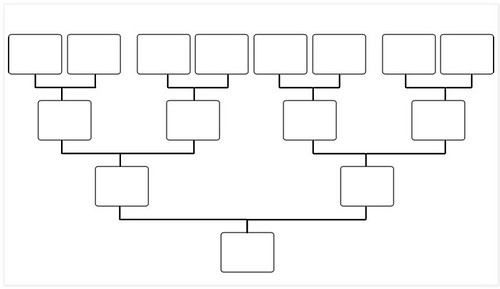

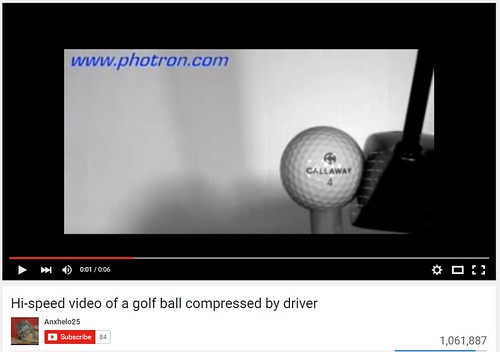
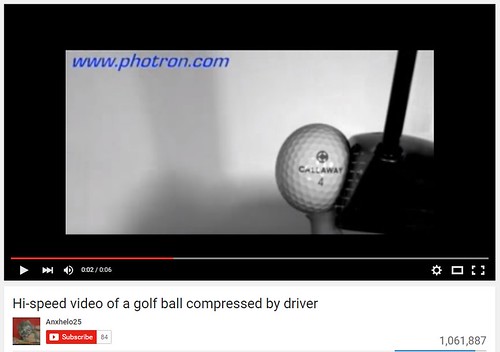
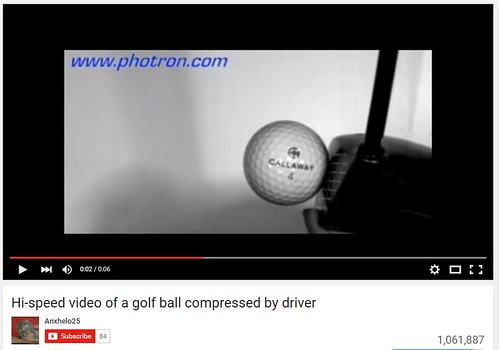
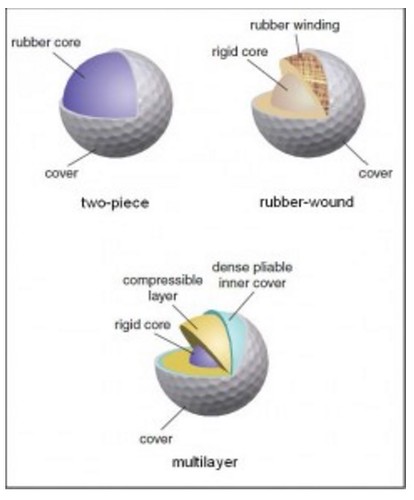
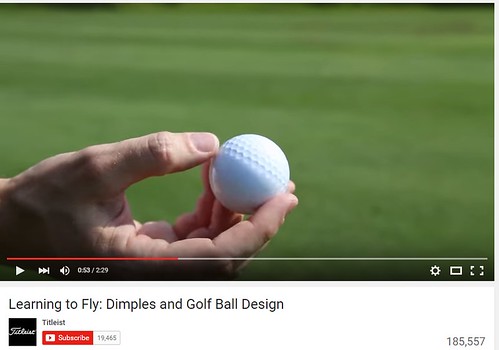
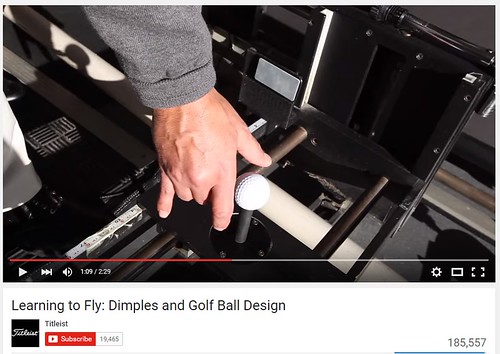


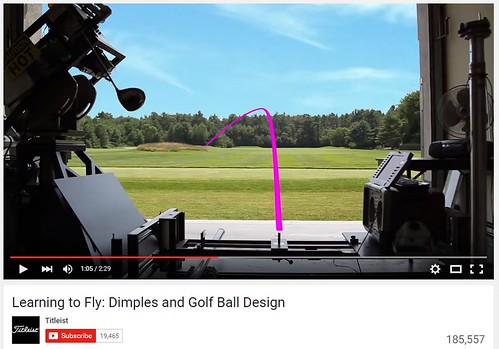
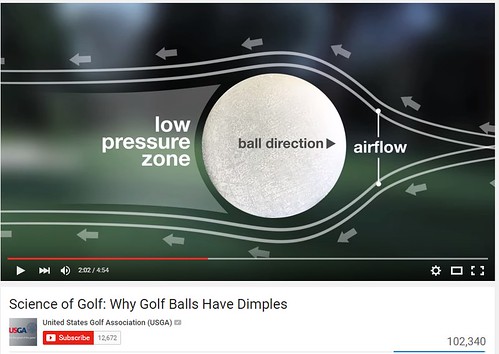

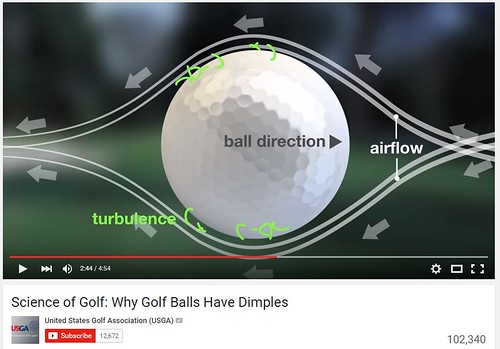
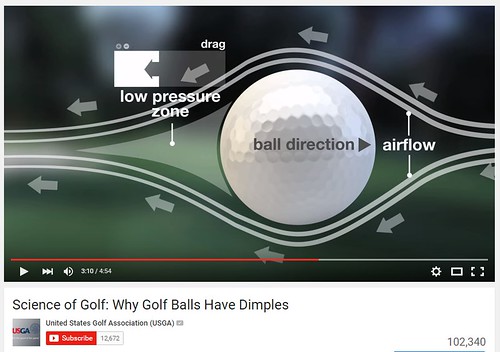
With your clubhead striking the turf on practically every shot, any dirt remaining on the clubface will undoubtedly influence the ball trajectory. Golf Towels
ReplyDelete